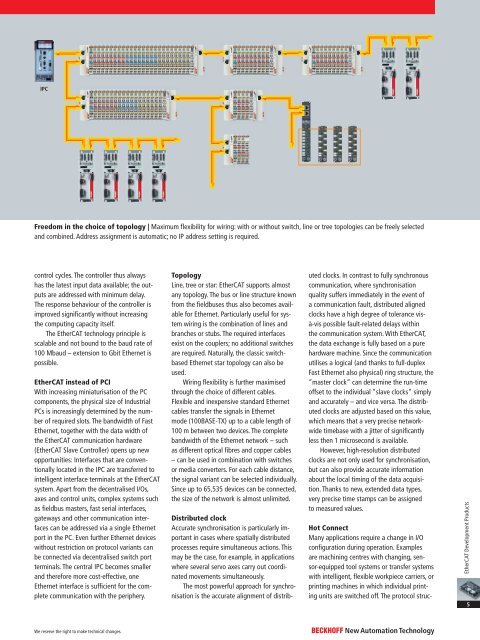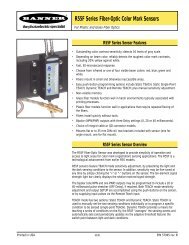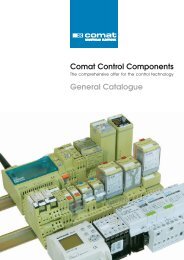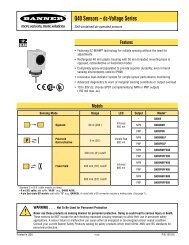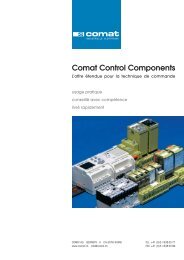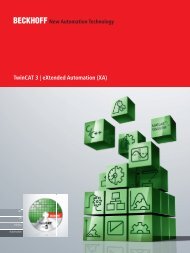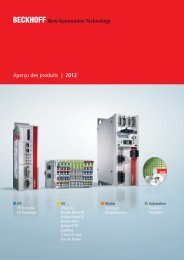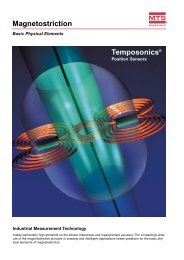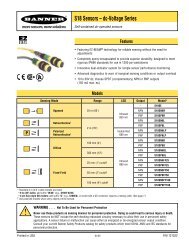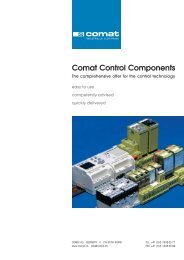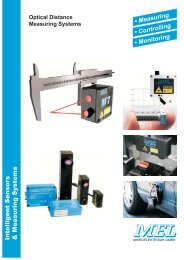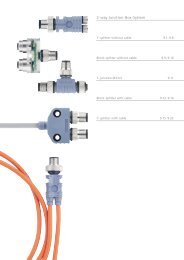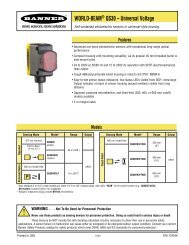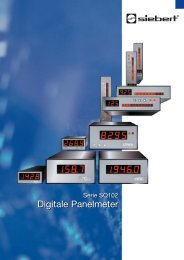Download - Multiprox
Download - Multiprox
Download - Multiprox
You also want an ePaper? Increase the reach of your titles
YUMPU automatically turns print PDFs into web optimized ePapers that Google loves.
IPC<br />
Freedom in the choice of topology | Maximum flexibility for wiring: with or without switch, line or tree topologies can be freely selected<br />
and combined. Address assignment is automatic; no IP address setting is required.<br />
control cycles. The controller thus always<br />
has the latest input data available; the outputs<br />
are addressed with minimum delay.<br />
The response behaviour of the controller is<br />
improved significantly without increasing<br />
the computing capacity itself.<br />
The EtherCAT technology principle is<br />
scalable and not bound to the baud rate of<br />
100 Mbaud – extension to Gbit Ethernet is<br />
possible.<br />
EtherCAT instead of PCI<br />
With increasing miniaturisation of the PC<br />
components, the physical size of Industrial<br />
PCs is increasingly determined by the number<br />
of required slots. The bandwidth of Fast<br />
Ethernet, together with the data width of<br />
the EtherCAT communication hardware<br />
(EtherCAT Slave Controller) opens up new<br />
opportunities: Interfaces that are conventionally<br />
located in the IPC are transferred to<br />
intelligent interface terminals at the EtherCAT<br />
system. Apart from the decentralised I/Os,<br />
axes and control units, complex systems such<br />
as fieldbus masters, fast serial interfaces,<br />
gateways and other communication interfaces<br />
can be addressed via a single Ethernet<br />
port in the PC. Even further Ethernet devices<br />
without restriction on protocol variants can<br />
be connected via decentralised switch port<br />
terminals. The central IPC becomes smaller<br />
and therefore more cost-effective, one<br />
Ethernet interface is sufficient for the complete<br />
communication with the periphery.<br />
Topology<br />
Line, tree or star: EtherCAT supports almost<br />
any topology. The bus or line structure known<br />
from the fieldbuses thus also becomes available<br />
for Ethernet. Particularly useful for system<br />
wiring is the combination of lines and<br />
branches or stubs. The required interfaces<br />
exist on the couplers; no additional switches<br />
are required. Naturally, the classic switchbased<br />
Ethernet star topology can also be<br />
used.<br />
Wiring flexibility is further maximised<br />
through the choice of different cables.<br />
Flexible and inexpensive standard Ethernet<br />
cables transfer the signals in Ethernet<br />
mode (100BASE-TX) up to a cable length of<br />
100 m between two devices. The complete<br />
bandwidth of the Ethernet network – such<br />
as different optical fibres and copper cables<br />
– can be used in combination with switches<br />
or media converters. For each cable distance,<br />
the signal variant can be selected individually.<br />
Since up to 65,535 devices can be connected,<br />
the size of the network is almost unlimited.<br />
Distributed clock<br />
Accurate synchronisation is particularly important<br />
in cases where spatially distributed<br />
processes require simultaneous actions. This<br />
may be the case, for example, in applications<br />
where several servo axes carry out coordinated<br />
movements simultaneously.<br />
The most powerful approach for synchronisation<br />
is the accurate alignment of distributed<br />
clocks. In contrast to fully synchronous<br />
communication, where synchronisation<br />
quality suffers immediately in the event of<br />
a communication fault, distributed aligned<br />
clocks have a high degree of tolerance visà-vis<br />
possible fault-related delays within<br />
the communication system. With EtherCAT,<br />
the data exchange is fully based on a pure<br />
hardware machine. Since the communication<br />
utilises a logical (and thanks to full-duplex<br />
Fast Ethernet also physical) ring structure, the<br />
“master clock“ can determine the run-time<br />
offset to the individual “slave clocks“ simply<br />
and accurately – and vice versa. The distributed<br />
clocks are adjusted based on this value,<br />
which means that a very precise networkwide<br />
timebase with a jitter of significantly<br />
less then 1 microsecond is available.<br />
However, high-resolution distributed<br />
clocks are not only used for synchronisation,<br />
but can also provide accurate information<br />
about the local timing of the data acquisi -<br />
tion. Thanks to new, extended data types,<br />
very precise time stamps can be assigned<br />
to measured values.<br />
Hot Connect<br />
Many applications require a change in I/O<br />
configuration during operation. Examples<br />
are machining centres with changing, sensor-equipped<br />
tool systems or transfer systems<br />
with intelligent, flexible workpiece carriers, or<br />
printing machines in which individual printing<br />
units are switched off. The protocol struc-<br />
5EtherCAT Development Products<br />
We reserve the right to make technical changes.<br />
BECKHOFF New Automation Technology


